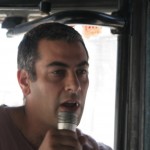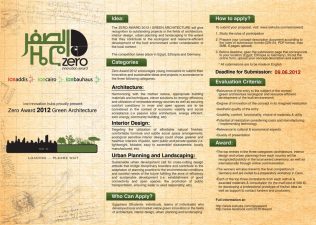(Kiryat Sefer resident and activist Miri Kupermintz on the park site. All photos by Daniella Cheslow)
A tour of Tel Aviv organized last week by the Cities of Tomorrow conference offered good news and bad news about the 100-year-old Hebrew city.
The good news is that it looks like the decade-long citizens’ battle to get a park instead of a high-rise in the Kiryat Sefer neighborhood is finally paying off. We visited the site, where activists have been running a weekly picnic for close to a year to push the city into creating a park. Right now it’s little more than a glorified sandlot (below), but in April the municipality okayed creating a green space in the 26 dunam (6.5 acre) lot. If you plan to be in the area on July 14, get ready for a major celebration as the park pushers mark their one-year anniversary.
Tour organizers Tovi Fenster (a geography professor at Tel Aviv U.) and Oren Shlomo (a master’s student in the department) were quick to point out that the residents of Kiryat Sefer are old-time Israelis with relatively easy access to the city’s centers of power. Further south was another conflict involving considerably less connected city residents.
 Yuval Tamari teaches at a public school in Yafo, the Arab city that makes up the southern part of Tel Aviv. He said that until a few years ago, all his students were Jewish. But because of Arabs moving into Jewish neighborhoods, his school’s student composition began reflecting a changing demographic mix. He said Jewish parents who had grown up in Yafo schools were worried that their kids wouldn’t feel at home as their classmates spoke Arabic to each other. Arabs aren’t the only ones moving in Yafo; Tel Aviv Jews have also moved into both older apartments and new gated residential projects.
Yuval Tamari teaches at a public school in Yafo, the Arab city that makes up the southern part of Tel Aviv. He said that until a few years ago, all his students were Jewish. But because of Arabs moving into Jewish neighborhoods, his school’s student composition began reflecting a changing demographic mix. He said Jewish parents who had grown up in Yafo schools were worried that their kids wouldn’t feel at home as their classmates spoke Arabic to each other. Arabs aren’t the only ones moving in Yafo; Tel Aviv Jews have also moved into both older apartments and new gated residential projects.
Tamari said his school moved to become more welcoming by hiring Arab teachers and celebrating Jewish, Muslim and Christian holidays. He also said the school has established a 50-50 quota for the percentage of Jewish and Arab students. The students’ parents are learning to adapt, while Tamari remains acutely aware of the possibility of “Jewish flight” and the need to balance the two sides.
What I took away from the tour is that while most cities have fluid populations, when it involves Jews and Arabs the Israeli gentrification issue takes on distinctly nationalist tones. For more, check out this piece by Josh Mitnick.




